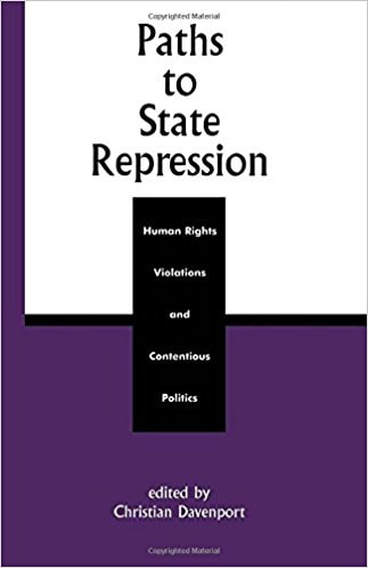Paths to State Repression: Human Rights Violations and Contentious Politics (solo editor)
INtro: Back in 1999, I had a conference at the University of Colorado (where I was employed at the time). The basic idea was to continue the discussion initiated by George Lopez and Michael Stohl in their series of books on the topic, including The State as Terrorist: Dynamics of Governmental Violence and Repression (1984), Government Violence and Repression: An Agenda for Research(1986) and Dependence, Development and State Repression (1989). These books are largely neglected but they serve as the foundation for much of what appears afterward.
Overview: In the last ten years, there has been a resurgence of interest in repression and violence within states. Paths to State Repression improves our understanding of why states use political repression, highlighting its relationship to dissent and mass protest. The authors draw upon a wide variety of political-economic contexts, methodological approaches, and geographic locales, including Cuba, Nicaragua, Peru, Sri Lanka, Indonesia, Israel, Eastern Europe, and Africa. This book is invaluable to all who wish to better under why central authorities violate and restrict human rights and how states can break their cycles of conflict.
Contents:
Chapter 1 Introduction
Part I: Domestic Threats, Dissent, and State Repression
Chapter 3. Domestic Threats: The Abuse of Personal Integrity
Chapter 4. Political Repression: Threat Perception and Transnational Solidarity Groups
Chapter 5. Protest Targeting and Repression: Campaigns against Water Projects in Indonesia
Part II: Exploring Dynamic Interactions
Chapter 7. Coercion and Protest: An Empirical Test Revisited
Chapter 8. Why Are Collective Conflicts Stable?
Chapter 9. Mobilization, Opportunity Structure, and Polity Responsiveness: The Role of Repression in the Intifada
Part III: Bringing the State Back In (Again)
Chapter 11. Protest, Democratization, and Human Rights in Africa
Chapter 12. Exploring the Ameliorating Effects of Democracy on Political Repression: Cross-National Evidence
Contributors: George Aditjondro, Christian Davenport, Ronald Francisco, Linda Camp Keith, John C. King, David Kowalewski, Drew Noble Lanier, Chris Lee, Kathleen A Mahoney-Norris, Sandra Maline, Susan McMillan, Will Moore, Steven Peterson, Steven Poe, Karen Rasler, James Scarritt and C. Neal Tate.
Artwork:
I have absolutely no idea where this picture came from. I was young.
Reviews:
All students of repression and dissent owe a debt to Christian Davenport and his collaborators, not only for assembling important evidence about how repression and dissent work in today's world, but also for looking hard at the way one incites the other—as well as thinking through conditions and interventions that might reverse vicious cycles of mutual destruction.
— Charles Tilly, Joseph L. Buttenwieser Professor of Social Science, Columbia University
A treasure-trove of articles.... Most repression research of the future will undoubtedly cite Paths to State Repression.
— American Political Science Review
The contributors to this timely volume tell us a lot about how democracy and human rights, on the one hand, and state repression and political coercion, on the other, influence social movements and political conflict. These original essays will be widely read and appreciated.
— Mark I. Lichbach, University of California, Riverside
- Rowman and Littlefield (2000).
INtro: Back in 1999, I had a conference at the University of Colorado (where I was employed at the time). The basic idea was to continue the discussion initiated by George Lopez and Michael Stohl in their series of books on the topic, including The State as Terrorist: Dynamics of Governmental Violence and Repression (1984), Government Violence and Repression: An Agenda for Research(1986) and Dependence, Development and State Repression (1989). These books are largely neglected but they serve as the foundation for much of what appears afterward.
Overview: In the last ten years, there has been a resurgence of interest in repression and violence within states. Paths to State Repression improves our understanding of why states use political repression, highlighting its relationship to dissent and mass protest. The authors draw upon a wide variety of political-economic contexts, methodological approaches, and geographic locales, including Cuba, Nicaragua, Peru, Sri Lanka, Indonesia, Israel, Eastern Europe, and Africa. This book is invaluable to all who wish to better under why central authorities violate and restrict human rights and how states can break their cycles of conflict.
Contents:
Chapter 1 Introduction
Part I: Domestic Threats, Dissent, and State Repression
Chapter 3. Domestic Threats: The Abuse of Personal Integrity
Chapter 4. Political Repression: Threat Perception and Transnational Solidarity Groups
Chapter 5. Protest Targeting and Repression: Campaigns against Water Projects in Indonesia
Part II: Exploring Dynamic Interactions
Chapter 7. Coercion and Protest: An Empirical Test Revisited
Chapter 8. Why Are Collective Conflicts Stable?
Chapter 9. Mobilization, Opportunity Structure, and Polity Responsiveness: The Role of Repression in the Intifada
Part III: Bringing the State Back In (Again)
Chapter 11. Protest, Democratization, and Human Rights in Africa
Chapter 12. Exploring the Ameliorating Effects of Democracy on Political Repression: Cross-National Evidence
Contributors: George Aditjondro, Christian Davenport, Ronald Francisco, Linda Camp Keith, John C. King, David Kowalewski, Drew Noble Lanier, Chris Lee, Kathleen A Mahoney-Norris, Sandra Maline, Susan McMillan, Will Moore, Steven Peterson, Steven Poe, Karen Rasler, James Scarritt and C. Neal Tate.
Artwork:
I have absolutely no idea where this picture came from. I was young.
Reviews:
All students of repression and dissent owe a debt to Christian Davenport and his collaborators, not only for assembling important evidence about how repression and dissent work in today's world, but also for looking hard at the way one incites the other—as well as thinking through conditions and interventions that might reverse vicious cycles of mutual destruction.
— Charles Tilly, Joseph L. Buttenwieser Professor of Social Science, Columbia University
A treasure-trove of articles.... Most repression research of the future will undoubtedly cite Paths to State Repression.
— American Political Science Review
The contributors to this timely volume tell us a lot about how democracy and human rights, on the one hand, and state repression and political coercion, on the other, influence social movements and political conflict. These original essays will be widely read and appreciated.
— Mark I. Lichbach, University of California, Riverside

